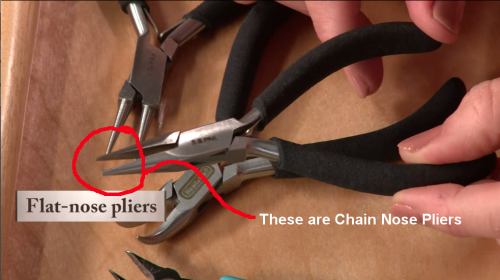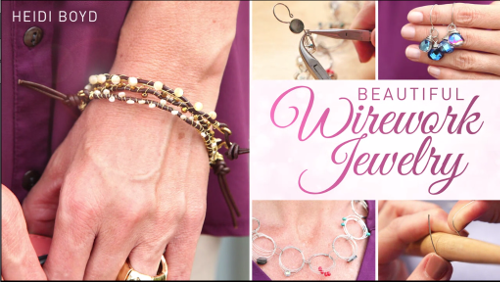I’m interested in emphasizing best practices in wirework, so I’m always on the lookout for what other people are teaching in their videos and books. Because so much of it is hit and miss, I’ve decided to start adding reviews, and turn my experience to your advantage.
Craftsy.com is one of the more well-known e-learning sites, with a huge range of craft subjects from quilting to knitting to jewelry making. Instructors are promoted as knowledgeable experts.
Today I’m going to review “Beautiful Wirework Jewelry” by Heidi Boyd, which was recently offered as a free video on Craftsy.
Boyd is described on her Craftsy bio as “an author, designer and dedicated crafter” who has written 15 books and appeared on HGTV and PBS.
“Beautiful Wirework Jewelry” is presented as a beginner class which introduces the viewer to “jewelry lingo” and takes you through three projects, a wire hoop necklace, wrapped drop earrings, and a leather and bead bangle. All three projects are in the “Boho” style, so a bit more freeform than some of the other jewelry offerings on Craftsy.
As with many beginner/crafter/hobby level videos, there is some good, a lot of bad, and some outright wrong info presented.
Heidi Boyd comes across as sweet and soft-spoken, but doesn’t seem entirely comfortable on camera; her speech is a bit stilted and she’s clearly reading from a script.
So, my observations:
Right away in “Basics of Wirework”, at :40, she says: “I’m the author of over a dozen craft books, many on subjects that were brand new to me.” [emphasis mine]
I never like hearing this from an instructor. Someone who is writing instruction books about subjects that are brand new to them will not have the expertise needed to catch and correct typical newbie mistakes.
This lack of expertise is put on glaring display at 2:28 when she calls what are clearly chain nose pliers “flat nose pliers”, and refers to the round nose pliers as “clever”. (The tools are listed correctly in the materials list pdf, downloadable with the project.)

Screenshot from Beautiful Wire Jewelry, video by Heidi Boyd on Craftsy.com
As the video goes on, she continues to stumble with the terminology, referring to a ring mandrel as a “mandr-elle”. Crafter/hobby-style tools are promoted, because these are inexpensive and accessible for a beginner just trying things out. However, the ring mandrel used in the video has no size markings on it, making it a virtually useless tool that you shouldn’t waste your money on.
Likewise, the use of plated copper (aka Artistic Wire) and brass wire is promoted as an affordable alternative to precious metals. For practice pieces, these types of wire are great for getting the feel of how the metal handles, but there are longer term durability issues that are not mentioned at all. Boyd does a decent job of explaining the basics of the various wire gauges and their uses.
In the next lesson, “Wire Hoop Necklace”, again she immediately gives her viewers bad advice by telling them to work directly from the spool. The reason why you should NOT do this becomes very clear about 30 seconds later when her spool starts to unravel itself and becomes a tangled mess.
The first hoop looks very sloppy because there are multiple beads pushing the loops in all different directions. Unfortunately “Boho style” in crafter-speak too often means that clumsy wire handling becomes a feature, not a bug.
It becomes hugely irritating, then, to hear this instructor make suggestions about how to make the wraps look more “professional”, when demonstrating clean technique in the first place would be just as easy and more effective.
Similarly, trimming off the ends and pressing them down so they don’t poke you is a absolute necessity in wirework. Cutting them off on the “outside” of the hoops so they can catch on your sweater can hardly be considered getting a “professional” look. The viewer should give up on any notion of achieving professionalism later in the video when any attempt at trimming the ends off properly is abandoned.
I’ve used the tool promoted in this video for making jump rings, and for a crafter-level tool, it can achieve fairly decent results. There’s a hole for threading and locking down the wire, and the tool can be spun to make a coil, but Boyd doesn’t demonstrate how to use it properly. In fact, I wondered why she didn’t just use a dowel. Her coil ends up loose and messy.
Cutting jump rings with the flush cutters, she demonstrates bad technique by not trimming both ends of the wire on the “finished” ring. As a result, there is a flush cut on one side and a beveled cut on the other side. This is a complete fail, and a bad habit to learn. While she does give correct info on how to open and close jump rings, the poor cuts result in rings that will never close properly. Jump rings need to have two flush ends that can butt up against each other cleanly. The best way to achieve clean cuts is with a jeweller’s saw or a jump ring cutter. It is possible, *in a pinch* to use flush cutters to cut cleans ends, but *only* if you don’t need your rings to be a consistent size, and then only when making a single or a few (i.e. less than 5). Using a flush cutter should never be a first choice.
Lessons 4 and 5 “Wrapped Drop Earrings” and “Leather and Bead Bangle” continue in much the same vein. The inconsistent nomenclature continues, as Boyd refers to refers to the “flat nose pliers”, which are actually chain nose pliers, as “needle-nose pliers”. Later she refers to them again as “flat nose pliers.” For a video that claims to teach proper lingo, this is going to leave newbies completely confused.
Working off the spool for the earwires, using the ring mandrel with no sizing, she doesn’t mark where she’s making her hooks. Instead, she makes the second earwire on top of the first before removing both, but admits “This is easier said than done – things shift around a little bit.”
She continues to wrestle and struggle with her tangled mess of wire, admitting finally “This can be awkward working on this wire.” Working off the spool tends to do that.
Good info about hiding the end of the wire that covers the face of the bead is contradicted by bad technique at the top of the bead, where she simply trims off the wire, doesn’t secure it, finish it or press it flat – it’s left sticking out!
In the bangle video, she stresses the importance of working safely, but doesn’t trim flush or file the ends of her wire. There is no information provided on how much 26 ga wire is needed for the beading wire. Shockingly, she comments “You want to try to space the beads consistently, but this is a handmade item, so…” This insinuates that poor construction is okay because it’s “handmade”. That comment epitomizes exactly why wireworking can be seen as having a bad reputation in the metalworking community. HANDMADE and WELL MADE are NOT mutually exclusive!
The finished bracelet looks flimsy – one good yank and it will deform.
While the overall video quality, sound and editing of “Beautiful Wire Jewelry” are good, I have to be blunt about the content: this video teaches a whole host of bad habits. There are obvious mistakes, slack attention to details, and Boyd recommends handling the wire in a way that sets the students up for no end of frustration and failure. These pieces can truly only be described as disposable jewelry. Wear ’em once, and be prepared to lose them or toss them. If you’re looking to make jewelry you can be proud of and that will last, avoid following the instructions offered in “Beautiful Wirework Jewelry”.
THE VERDICT: Not enough redeeming info to make up for the mountain of bad techniques. Run Away! Run Away!
NB – To learn how to properly make a single or *very* small number of jump rings using a flush cutter, how to cut jump rings with a jeweller’s saw, and how to cut jump rings with a jump ring cutter and a Foredom, please visit the video library here on The Tao of Wire.


